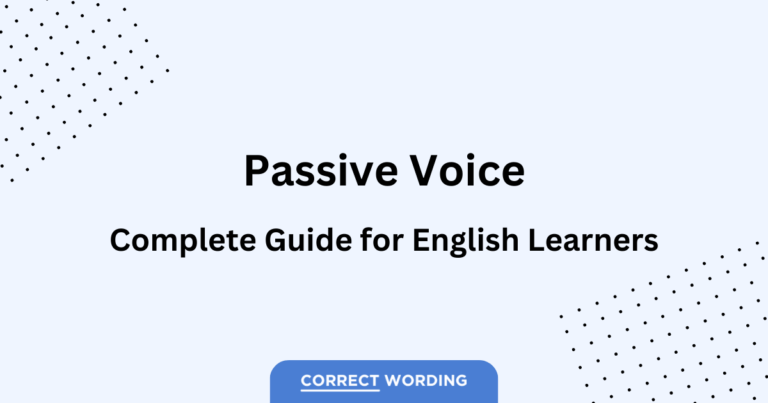Past Participle: A Simple Guide for English Learners
The past participle, in the English language, is a verb form typically used to indicate a completed action or condition.
For instance, in the phrase “The cookies were eaten,” “eaten” is the past participle, signifying an action that has already occurred.
It is crucial to differentiate between regular and irregular verbs when forming past participles.
Regular verbs form the past participle by appending “-ed” to the base form (e.g., “play” becomes “played”). In contrast, irregular verbs adopt various forms (e.g., “eat” becomes “eaten”).
Past participles hold significance not only as markers of past actions but also as essential components in creating verb tenses such as the present perfect (“has eaten”) and passive constructions (“was eaten”).
In subsequent sections, we will delve deeper into the practical usage, formation, and common errors associated with past participles, aiming to provide a straightforward guide to mastering its application in English communication.
How to Form Past Participles
When we talk about past participles, the way we make them depends on the type of verb. There are two main types: regular and irregular.
Regular Verbs
For regular verbs, forming the past participle is straightforward. We add “-ed” to the verb.
- Walk -> Walked
- Play -> Played
- Work -> Worked
Irregular Verbs
Irregular verbs are a bit trickier. They don’t have a fixed pattern and can change in different ways.
- See -> Seen
- Go -> Gone
- Drink -> Drunk
It’s essential to remember these forms or check them when unsure, as they vary a lot.
Using Past Participles in Sentences
Past participles are not just about showing actions that happened in the past. They play important parts in sentences in a few different ways.
In Perfect Tenses
Past participles help us make perfect tenses. We use them with “has,” “have,” or “had.”
- Present Perfect: I have eaten lunch.
- Past Perfect: She had gone home.
- Future Perfect: They will have finished the project.
In Passive Voice
We also use past participles to make sentences in the passive voice. This is when the focus is on the action and not who did it.
- Active: The cat (doer) chased (action) the mouse (receiver).
- Passive: The mouse (receiver) was chased (action) by the cat (doer).
In passive sentences, we use “be” (is, am, are, was, were) plus the past participle.
- The letter was sent.
- The cake is baked.
In the next parts, we’ll explore more ways to use past participles and how to avoid common mistakes.
Past Participles as Adjectives
Past participles don’t only work as verbs. They can also act like adjectives, giving us more information about nouns.
Describing Objects
Past participles can describe objects. They tell us about a state or condition.
- The broken toy is in the trash.
- She wore a worn jacket.
In these sentences, “broken” and “worn” give us more information about the toy and the jacket.
Describing Feelings
We also use them to talk about how someone feels.
- I am bored.
- She feels excited.
“Bored” and “excited” describe feelings but come from verbs (“to bore” and “to excite”).
Understanding that past participles can work in these different ways helps us make richer, more descriptive sentences.
Common Mistakes and How to Avoid Them
Using past participles the right way can be tricky. Let’s look at some common mistakes and how to fix them.
Using the Wrong Form
Sometimes, people use the wrong form of the past participle, especially with irregular verbs.
- Not Correct: They have ran to the store.
- Correct: They have run to the store.
Using the right form, like “run,” is important when we talk about something that has happened.
Mixing Up Simple Past Tense and Past Participle
Another mistake is mixing up the simple past and past participle forms of verbs.
- Not Correct: I have did my homework.
- Correct: I have done my homework.
Remember, “did” is simple past and “done” is past participle. We use “done” with “have.”
Using Past Participles Wrong in Passive Sentences
Sometimes, people use the wrong words when making passive sentences.
- Not Correct: The song was sang by the choir.
- Correct: The song was sung by the choir.
In passive sentences like this, we use “sung,” not “sang.”
By watching out for these mistakes and practicing using past participles the right way, you’ll get better at using them in your talking and writing.
Expert Tips and Mnemonics for Learning Past Participles
Mastering past participles is foundational for fluent communication. Adopting strategies and mnemonics can smoothen this learning journey.
Effective Strategies for Memorization
- Create Flashcards: Write the base verb on one side and its past participle on the other. Use them to test your memory.
- Use in Context: Whenever you learn a new verb, try to use its past participle in a sentence. This practical application enhances memory retention.
- Engage in Regular Practice: Consistently review and utilize past participles to reinforce your learning.
Examples of Mnemonics
Mnemonics, or memory aids, can be a fun and effective way to remember past participles of irregular verbs.
- Sing a Song: Turn the irregular verbs into a catchy tune. For example, singing verbs to the tune of a familiar song can make recall easier.
- Rhyme Them: Create rhymes using verbs. “The mouse ran away, but he has run to stay,” helps to remember “ran” (past) and “run” (past participle) are forms of “run.”
- Group Similar Verbs: Put verbs with similar changes together. For instance, “sing, sang, sung” and “ring, rang, rung” have a similar pattern.
Implementing Knowledge: Practice Tips
- Mindful Reading and Listening: Be attentive to the use of past participles while reading books or listening to conversations.
- Daily Usage: Aim to use a few new past participles in your daily conversations or writings.
- Seek Feedback: When practicing, get feedback from proficient speakers or use language learning apps.
Practice Makes Perfect
Getting good at using past participles takes some practice. Let’s go through some exercises to help you get the hang of it.
Quick Exercises
- Fill in the Blanks: Use the correct past participle form.
- She has __________ (go) to the school.
- The window was __________ (break) during the storm.
- Find Mistakes: Spot and correct the mistakes in these sentences.
- They have went to the playground.
- The email was send yesterday.
- Form Sentences: Use the given words to make sentences using past participles.
- (The cake, bake)
- (The song, sing)
Quick Exercises Answers
Fill in the Blanks:
- She has gone to the school.
- The window was broken during the storm.
Find Mistakes:
- They have gone to the playground.
- The email was sent yesterday.
Form Sentences:
- (The cake, bake) – The cake has been baked.
- (The song, sing) – The song has been sung.
Remember, the key to getting comfortable with past participles is to practice them in different ways. The more you use them, the easier they get. So, keep practicing!
Advanced Uses and Exploration
Let’s dive deeper into the world of past participles and look at some fancy ways we can use them in English.
We’ll explore something called participial phrases and also play with cleft sentences.
Playing with Participial Phrases
Participial phrases are groups of words that add more information about a noun (like a person, place, or thing) in a sentence. They start with a past participle! Let’s look at an example:
- Excited, the dog wagged its tail. “Excited” tells us more about the dog and is our participial phrase here.
Using Reduced Relative Clauses
Next, we can use past participles to make sentences shorter but still clear. This is known as using reduced relative clauses. Look at this sentence:
- The cake (that was) eaten by the kids was chocolate. We can take out “that was” and still understand the sentence: “The cake eaten by the kids was chocolate.”
Trying Out Cleft Sentences
Now, cleft sentences help us stress or highlight a particular part of a sentence. They often use “what” or “it” to help shift our focus.
- It was the clown who made the balloon animals. Here, we’re putting a spotlight on “the clown” to make sure we know who made the balloon animals.
These tricks help us add detail, keep sentences short and focused, and highlight important bits of information using past participles in our English sentences.
Conclusion
Navigating through past participles, we’ve learned various ways they enliven English. From forming tenses to using them in different sentence structures, their versatility is clear.
Key points to remember: know how to form past participles, understand their basic and advanced uses, and practice to avoid common mistakes. Mastery comes with regular use and practice, so keep applying what you’ve learned in your conversations and writing.
Embrace your learning journey and let your knowledge of past participles enhance your communication in English. Keep exploring and enjoying the diverse world of English grammar!




